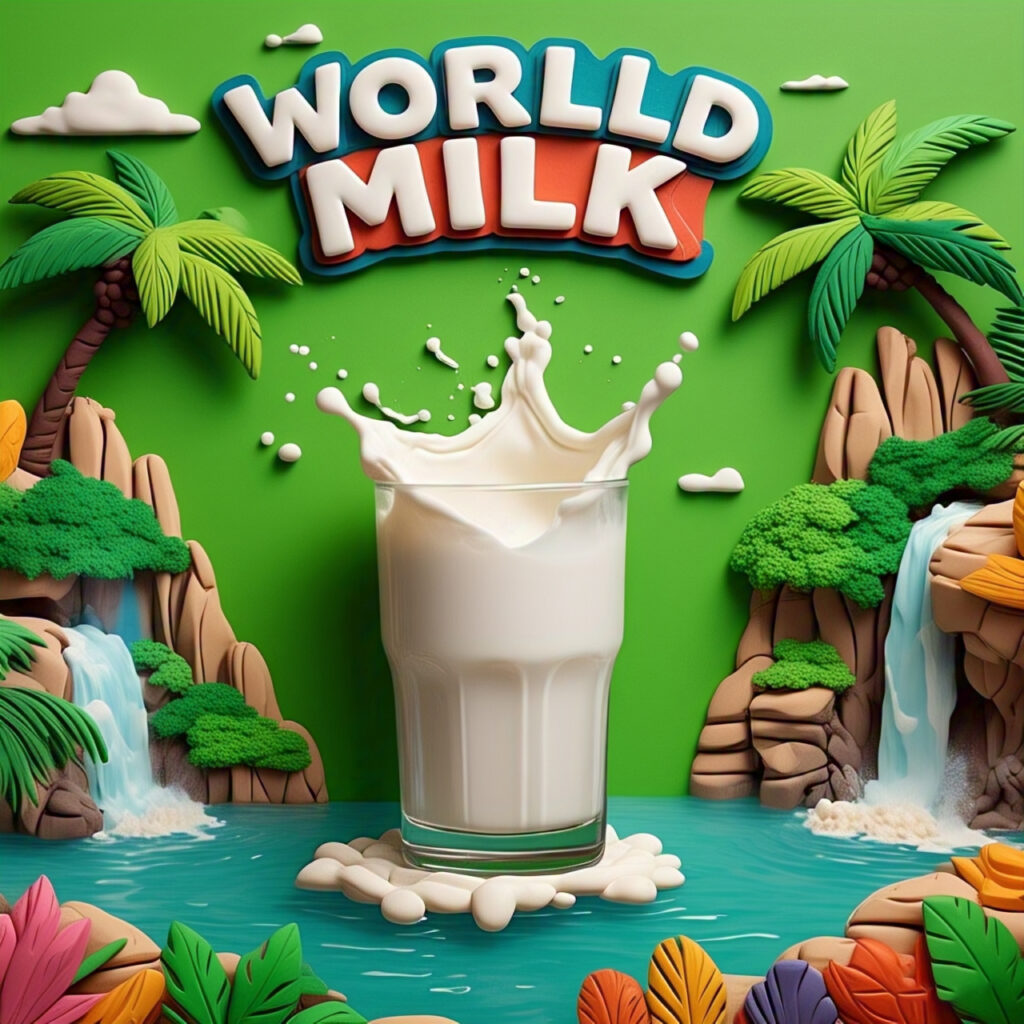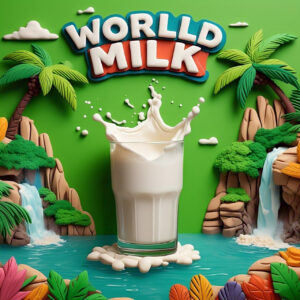
Milk is one of the most complete natural foods known to mankind. Rich in essential nutrients, it has nourished humans for millennia. To recognize its importance and to raise awareness about the dairy sector’s contributions to nutrition, livelihoods, and sustainable development, World Milk Day is celebrated annually on June 1st. Initiated by the Food and Agriculture Organization (FAO) of the United Nations in 2001, this day has since become a global celebration of milk and dairy products, involving hundreds of countries, organizations, and millions of people around the world.
This article delves into the origins, significance, health benefits, economic value, environmental aspects, and celebrations associated with World Milk Day.
Origins of World Milk Day
The Food and Agriculture Organization (FAO) of the United Nations established World Milk Day in 2001 to acknowledge the importance of milk as a global food. June 1st was chosen to mark the day because several countries were already celebrating a national milk day around this time.
The aim was to:
-
Highlight the importance of milk in healthy diets.
-
Support the livelihoods of dairy farmers.
-
Promote dairy industry efforts in sustainability and economic development.
Since then, World Milk Day has grown into a global movement, with thousands of events ranging from awareness campaigns and milk drives to marathons and school programs.


The Nutritional Power of Milk
Milk is often called “nature’s most perfect food”, and for good reason. It is a rich source of:
-
Calcium: Essential for strong bones and teeth.
-
Protein: High-quality complete proteins for muscle growth and repair.
-
Vitamins: Especially Vitamin D (in fortified milk), B12, A, and riboflavin (B2).
-
Minerals: Phosphorus, potassium, and magnesium.
-
Fats: Including healthy fats and essential fatty acids.
-
Carbohydrates: Mainly in the form of lactose for energy.
Milk and dairy products form an integral part of diets in many cultures, recommended particularly for children, pregnant women, and the elderly due to their dense nutritional content.
Milk and Bone Health
Calcium and Vitamin D are crucial in maintaining bone density and preventing conditions like osteoporosis. Regular milk consumption during childhood and adolescence helps in achieving optimal peak bone mass.
Milk and Muscle Building
The high-quality protein in milk contains all nine essential amino acids, making it ideal for muscle repair and growth. That’s why milk is often recommended post-exercise.

Global Milk Consumption Patterns
Milk is consumed in many forms worldwide, and its cultural relevance varies significantly:
-
India, the world’s largest producer and consumer of milk, integrates it into daily meals, sweets, and religious rituals.
-
In Europe and North America, milk and dairy are central to diets, especially in the form of cheese, butter, and yogurt.
-
African countries are seeing a rise in milk demand due to urbanization and income growth.
-
East Asia, historically low in dairy consumption due to high rates of lactose intolerance, has shown increasing demand for lactose-free and plant-based alternatives.
The global dairy industry caters to billions of consumers, making milk one of the most traded agricultural commodities in the world.

Economic Importance of Dairy
A Source of Livelihood
The dairy sector supports over 1 billion people globally, from smallholder farmers to large-scale processors and marketers. In developing countries, dairy farming often provides critical income for rural households.
Women in Dairy
In many regions, especially South Asia and Africa, women play a pivotal role in dairy farming. Milk production empowers women by enabling them to earn and manage household income, thus improving family welfare and children’s education.
A Key Contributor to GDP
In countries like India, New Zealand, and the Netherlands, dairy contributes significantly to the national economy. In India alone, the dairy industry contributes around 4% to the GDP and is one of the largest employers in the agriculture sector.

Milk and Sustainability
As with all food systems, dairy farming has both positive and negative environmental impacts.
Environmental Challenges
-
Greenhouse Gas Emissions: Cows emit methane, a potent greenhouse gas.
-
Land and Water Use: Dairy farming requires large amounts of water and land.
-
Manure Management: Poorly managed manure can contaminate water bodies and release harmful gases.
Solutions and Innovations
The industry is increasingly adopting sustainable practices, such as:
-
Improved feed efficiency to reduce methane emissions.
-
Renewable energy adoption in dairy farms and processing units.
-
Water recycling and waste management systems.
-
Promoting pasture-based systems which are more eco-friendly.
Several global dairy coalitions are working towards making dairy farming carbon-neutral, focusing on reducing emissions while improving animal welfare and farmer livelihoods.
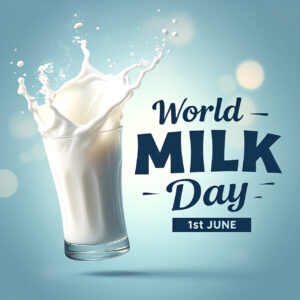
Celebrating World Milk Day Around the World
World Milk Day is marked with enthusiasm in both urban and rural areas. Governments, dairy companies, educational institutions, and health organizations host a wide range of activities.
Common Celebrations
-
Milk Distribution Drives: Providing milk to children and underprivileged communities.
-
Educational Campaigns: Schools and media promote awareness about milk’s nutritional value.
-
Dairy Farm Visits: Organizing trips for students to learn about dairy production.
-
Competitions: Poster making, slogan writing, recipe contests, and social media challenges.
-
Marathons and Rallies: Fitness events to highlight the role of milk in health.
-
Online Campaigns: Hashtags like #WorldMilkDay and #EnjoyDairy trend across platforms.
Role of the Dairy Industry
Major dairy companies often use World Milk Day to:
-
Showcase innovations in processing and packaging.
-
Promote sustainability commitments.
-
Launch new dairy products and campaigns.
Government Support
Countries like India, New Zealand, and the USA use this day to unveil policy initiatives related to dairy development, subsidies, and farmer support.
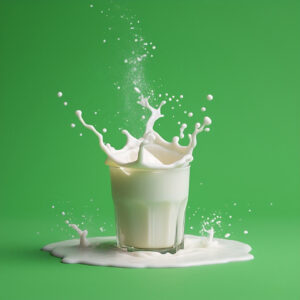
Plant-Based Milk Alternatives: A New Era?
While dairy milk remains popular, there has been a rise in plant-based alternatives like almond, soy, oat, and coconut milk. These alternatives are often chosen due to:
-
Lactose intolerance or dairy allergies.
-
Vegan or vegetarian lifestyles.
-
Environmental concerns over dairy farming.
World Milk Day has increasingly begun to acknowledge milk in all forms, including dairy and plant-based, promoting a message of nutrition, sustainability, and choice.
The Role of Milk in Culture and Religion
Milk is not just a food product—it holds symbolic value in many cultures:
-
In Hinduism, milk is considered pure and used in rituals and temple offerings.
-
In Christianity, milk symbolizes spiritual nourishment.
-
In Islam, milk is praised in the Quran and was consumed by Prophet Muhammad.
-
In many African and Indigenous cultures, milk is central to social rituals and traditional medicine.
The presence of milk in proverbs, folklore, and ancient texts underlines its deep-rooted significance in human history.
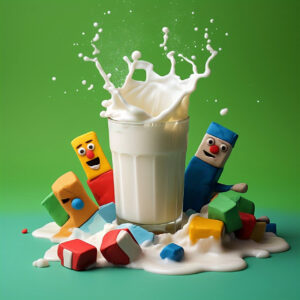
The Future of Dairy
Innovations in Dairy Farming
The future of dairy lies in technology and innovation. Farms today are integrating:
-
Robotic milking machines
-
Smart sensors for animal health monitoring
-
AI-based feed management systems
-
Biogas and solar energy for farm operations
These advances help increase yield, reduce labor, and minimize environmental impact.
Health-Focused Dairy Products
There is growing demand for:
-
Low-fat and lactose-free milk
-
Probiotic-rich yogurts
-
Fortified dairy (with Vitamin D, calcium, etc.)
-
Functional dairy drinks with added protein and collagen
Global Dairy Challenges
Despite its benefits, the dairy sector faces several challenges:
-
Climate change and water scarcity
-
Market volatility and price fluctuations
-
Animal rights and ethical concerns
-
Public health misinformation
Addressing these challenges will require collaboration among farmers, governments, scientists, and consumers.

world-milk-day-june-1-poster-free-design
Why World Milk Day Matters
World Milk Day is more than a celebration; it is a call to action. It brings attention to:
-
The role of milk in fighting malnutrition.
-
Supporting small farmers and rural economies.
-
Making dairy more inclusive and sustainable.
-
Encouraging responsible consumer choices.
In a time when food systems are under scrutiny, World Milk Day reminds us of the value of dairy in our past, present, and future.

world-milk-day-june-1-poster-free-design

